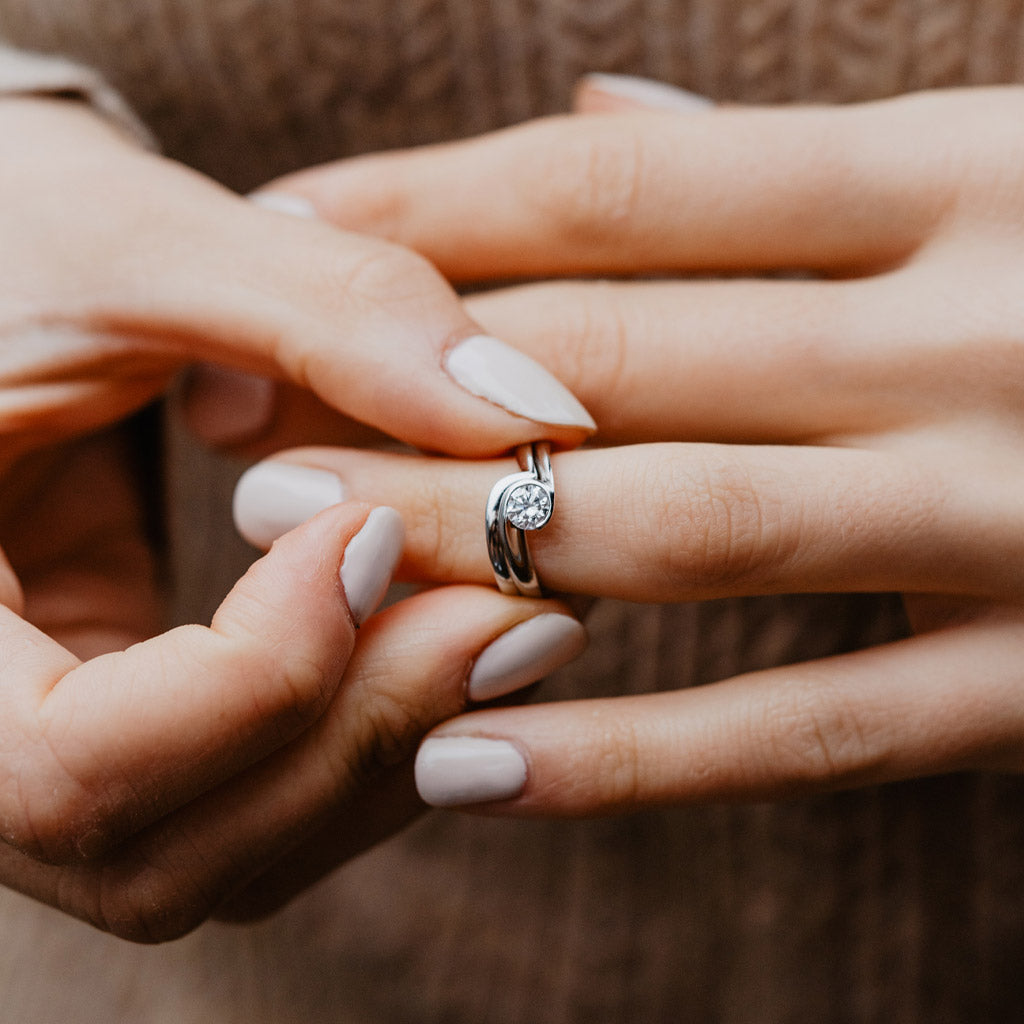They say diamonds are a girl’s best friend and when it comes to engagement rings many would agree that diamonds are a must, but at what cost? The global diamond trade has a dark side, blood diamonds also referred to as conflict diamonds are associated with several harsh realities; the industry funds civil wars and ongoing violence, exploitation and suffering of workers as well as environmental degradation. These conflict diamonds are being mined in violent and unethical situations and in some cases military and police officials have been linked to the mining companies harvesting these conflict diamonds. In 1998 Global Witness released a report that exposed the use of conflict diamonds funding the civil war in Angola, Africa. This raised awareness and opened up important conversations about the negative activities occurring in the global diamond industry with many conflict diamonds still being sold unknowingly to the public. In addition to the humanitarian issues, have you ever thought about the price of a Earth mined diamond beyond its monetary value? Sure the 4Cs are important to understand when purchasing a diamond as that is how the cost of the diamond is determined. But beyond the 4Cs and monetary cost, there is a huge price that is paid for all that natural sparkle. At Ethica Diamonds we refer to this cost at the 5th C - conflict. Diamond Buying Guide It’s hard to imagine that in 2020 conflict diamonds are still a problem, but if you stop to think about it, are you really surprised that they are? We live in a time where everything is disposable from consumer goods to the lives of the people producing these products. Sure you might think twice before buying fur, factory farmed meat or even shopping at big name retailers using child labour to create your favourite shoes or clothes - but what about that diamond on your finger? According to Bain & Company, about 133 million carats of rough diamonds are mined each year - with 65 percent of them originating from Africa. Then consider the fact that only 1 in 4 (25%) of diamond mines in Africa are well regulated, we can assume 3 of every 4 diamonds mined in Africa has a history of environmental and humanitarian abuses. This equals nearly 65 million diamonds that are hitting the international diamond market each year, or at least 1 in 13 diamonds on the international market coming from a conflict origin. While diamonds are loved internationally - The U.S. was the main growth market for diamond jewellery sales in 2016 and accounts for nearly half of all demand worldwide. In a CNBC article, Alice Harle, an expert on minerals from the nonprofit organisation Global Witness, shared that the "conflict diamond problem has not gone away. Companies sourcing diamonds originating in countries like Central African Republic and Zimbabwe may risk indirectly supporting violence." In fact, Human Rights Watch release a report in February 2018 scrutinising “steps taken by key actors within the jewellery industry to ensure that rights are respected in their gold and diamond supply chains.” The report highlights the varying policies and practices of 13 major jewellery brands in their efforts, and failures, to responsibly source their diamonds. If you consider yourself a conscious consumer, a minimalist, or simply care about the impact your purchasing decisions have on the world around you, then you know that less is more. This could not be more true than when it comes to jewellery. Most of the fine jewellery you purchase will probably still be in your possession for many years to come, so you want those pieces to be special, beautiful gems that you really love and feel represent you. And of course, that means prioritising ethics, sustainability, and transparency in the production process, too. Sustainable jewellery is therefore becoming increasingly popular, with couples choosing Earth friendly engagement rings, and opting for diamonds that don’t ‘cost the Earth’ when they get engaged. Please join us in looking at the sustainability, or otherwise, of mined diamonds, and what alternatives are available. Unsustainable Mined Diamonds Any resource that is dug from the ground is inherently unsustainable – whether that is coal, gold, platinum, sapphires or diamonds. These things were all created millennia ago, and there is no way to put them back once they’ve been extracted. Additionally, they don’t exist in the form of a solid lump of the item, but are encased in surrounding rocks, which need to be dug out, broken up, in some cases melted down, but certainly processed to get at the treasure within. The environmental damage caused by any mining operation is extensive, with loss of topsoil and habitats, waste products leaching heavy metals in the surrounding water table, mountains of waste rock sitting around the landscape, plus machinery and vehicles involved in extraction polluting the area. Diamond occurs in an ore called Kimberlite, which occurs in slender conical pipes, thus many diamond mines are similarly deep and conical, However, these pipes do have a point, and once it becomes financially unrealistic to continue mining at that location, another pipe must be found. Sometimes these pipes occur in convenient clusters but this is not always the case. Diavik Mine - Canada Diavik Diamond Mine - Canada Ekati Diamond Mine - Canada Ekati Diamond Mine - Canada Undersea Mining Another source of diamonds is to be found under the sea. There is one area in particular, at the mouth of the Orange River between Namibia and South Africa, where diamonds have been washed free from the ore, and swept out to sea, over hundreds of years. Offshore the southwest coast of Namibia, five specially designed ships are mining the seabed in search of marine diamonds washed into the Atlantic Ocean by the Orange River. Since 2002, Debmarine Namibia, owned in equal shares by the Namibian Government and diamond miner De Beers, has held an offshore mining licence that has so far produced around five million carats of diamonds from the relatively shallow waters. The area is an important mining frontier for both Namibia and De Beers. Namibia is famous for its high-quality diamonds and is amongst the top ten producers in the world, relying heavily on the income the gems generate. But the country is expected to run out of land-based gem mining in around 15 years, so is becoming increasing dependent on marine mining. To exploit these diamonds, which are found in water depths of up to 150m, a specialist process is conducted using advanced equipment. In the last year, De Beers has invested heavily in upgrading this equipment. The Process Diamonds were first discovered offshore Namibia in the 1960s. Over the years, coastal waters have produced around 95 million carats, including around 12 million from deepwater marine mining. While in the past many ingenious methods have been deployed to liberate the diamonds from the seafloor, today the process is highly sophisticated and fully automated. First, to find the most lucrative areas to mine, the seabed is scanned using unmanned and remotely operated vehicles equipped with geophysical mapping technology. This is followed by sampling to determine a reserve’s inventory. The findings, along with other parameters, form the basis of a mine plan, which the company says “ensure the diamonds identified are brought to the surface in the safest and most sustainable, and economic way.” To remove the precious gems, a horizontal crawler is attached to one of the company’s vessels, which then moves along the specific area dredging up the seabed. Different mining technologies are deployed to suit different ground conditions. These include an airlift-drill technology, which uses a 6.8m-diameter drill bit working in overlapping circles on the sea floor, and a crawler, which uses a 280-tonne track-mounted crawler to dredge the sea floor. Four of the production vessels use the airlift-drill, whilst only one vessel – Mafuta – uses the crawler. Up to 60 tonnes of sediment are lifted up to the vessel through a giant pipe each hour. Aboard the ship, the sediment is then washed and sifted into increasingly smaller stones, using a series of vibrating racks and rotating drums that crush rocks. Sediment that is non-diamond bearing is dumped and discarded back to the ocean floor. Any diamonds that are found are sealed in small barcoded containers and flown, three times a week, by helicopter to vaults ashore. This company, Debmarine, has rights to mine an area of 2.316 square miles, of which they have worked through around 2-3% so far, with an estimated 27% thought to contain viable diamonds. The Environment As you can imagine, under sea diamond mining is not a sustainable exercise, with fish and marine life sucked up along with the sand and rocks, spat out and separated from habitats, colonies and food sources because although the long-term effects of land mining are widely known, the impact of offshore mining is much less understood. Debmarine claims rehabilitation of mined marine environments occurs naturally, and recolonisation and recovery takes place once mining operations have ceased in a particular area. The company actively monitors the environment through surveys conducted by independent scientists, the results of which are published in an annual report and peer-reviewed. According to an article by The Wall Street Journal in July last year, operators controlling the dredging equipment sometimes see fish and octopus sucked up by the hose, but they appear to survive as they are returned to the sea. Still, environmentalists are concerned about the lack of knowledge about the long-term effects of seabed mining. “The worry is that we are going to irreparably harm this environment and these species before we discover them,” Emily Jeffers, an attorney with the Centre for Biological Diversity, told the Post. Furthermore, a 2014 policy briefing from the Governance of Africa’s Resources Programme (GARP), which is funded by the Norwegian Ministry of Foreign Affairs, notes that potential impacts of this kind of mining include the removal of mined material, along with organisms living on or under the seabed; the perturbation of the seabed; and the introduction of new materials to the environment. However, despite environmentalists’ concerns, the offshore mining sector shows no signs of slowing down. In other studies, it has been shown that marine life is adversely affected by even boats passing overhead, so the impact of total destruction of habitats cannot be overstated. This area is located close to the historic and protected so who is to say that there wasn’t some species of value to the medical field, or exhibiting unique behaviour, hiding in the silt, that is now lost forever? No, under-sea diamond mining is sustainable, even though it is less visible than traditional mining. Cape Fur Seals - Skeleton Coast Devastation - Cape Fur Seals - Skeleton Coast Namibia location map Canadian Diamond Mining If you ever see any material about Canadian diamonds, on the web or in print, you will probably be aware that Canadian diamonds are marketed as conflict free, ethical, sustainable and generally superior to other mined diamonds. We have a series of blogs looking more closely at the Canadian diamond mining industry, where we examine this claim in more depth, but the short version is that Canadian Diamonds aren’t by any means perfect, though they are better than some. Are Canadian Diamonds Ethical? - Part 1 Are Canadian Diamonds Ethical? - Part 2 Are Canadian Diamonds Ethical? - Part 3 There is no evidence to say that Canadian Diamonds are in any way conflict diamonds or blood diamonds, at least in terms of human suffering - no-one has ever claimed that, and we would not like that to be inferred. However, there are certainly questions around the mining companies’ treatment of First Nations tribes, who own the land where diamonds have been found. And the issues of landscape, wildlife, pollution, and reclamation of the land post-mining are all forms of conflict in Canada. Questions are also being raised in some circles about whether stones that are being sold as ‘Canadian’ do in fact originate from somewhere else. We will be looking at this in a future blog. It’s the equivalent to someone selling regular food products as ‘organic’; charging a premium, fooling consumers, and risking the believability and authenticity of the rest of the organic food production system. Sustainable Lab Grown & Man Made Diamonds Lab grown, or man-made diamonds are, as their name suggests, created in a lab, rather than mined. They are diamonds in every sense – chemically, structurally, visually – just without the environmental and ethical stain of mined diamonds. The modern method of creating diamonds (Chemical Vapour Deposition – CVD) is to place a seed, usually a tiny sliver of diamond, in a methane rich environment, and subject it to plasma or microwaves. This causes the methane molecules to break apart, becoming water and carbon, which condenses like dew on the diamond seed. At the end of the process, the diamond is then cut and polished, as a mined diamond would be. It can take several weeks to create a good-sized diamond by this method, but it still requires much less energy per carat than extensive mining operations. Source: Environment Impact Assessment Frost & Sullivan Report If you line up mined diamonds and Man-made diamonds side by side with their relative environmental impacts, it’s not hard to draw conclusions about which is more sustainable. One is dug from the ground, with extensive waste products, massive energy input, carbon-intensive heavy machinery and disastrous environmental damage. The other is created in a monitored environment in a laboratory, generating only water as a by-product, with a tiny percentage of the energy use, and negligible environmental impact. If the energy source is renewable, if the carbon is offset, then there is very little impact on the Earth at all, despite the claims of those backing the mined diamond business, who are trying to discredit this very real threat to their livelihoods. Once you add in the fact that a lab-grown diamond is not linked to any form of humanitarian abuses, that is conflict free, and usually priced between 20% and 30% lower than an equivalent mined diamond, then it’s easy to see why consumers are heading in the direction of man-made diamonds. The Ethica Diamond - Most Sustainable We are proud to claim that our Ethica Diamonds, featured in the Ethica Diamond collection, are even more sustainable and eco-friendly than a lab-grown diamond. The Ethica Diamond is our exceptionally engineered signature gemstone that has the toughness, longevity, brilliance and independent grading which exactly matches that of pure diamonds. Every stone is consistently VVS1 in clarity, E in colour, and Ideal cut, or Hearts and Arrows cut in the case of round brilliants, which is the best cut available. The Ethica Diamond has been created by a university who are market leaders in gemstone science, combining the latest technology together with the least impact on the environment. It is also independently certified by a trusted global research institute and each stone is laser marked for identification and verification purposes. The certificates that we provide are also a trusted means of insuring any piece of our jewellery. It is chemically and physically similar and optically identical to a diamond found in nature. It is grown under strict conditions and is cut and fully faceted to exact diamond proportions, giving it incredible depth and realism. This stone truly radiates the same sparkle and brilliance as the most expensive Earth mined diamonds and are made to last forever. Since the creation of the Ethica Diamond is not tied to the diamond industry, and unlike mined diamonds and lab grown diamonds, it is independently priced, based on the cost of production and research & development, rather than being artificially inflated. Therefore, we are able to bring them to the customer at a fair price. We take pride in the fact that our Ethica Diamonds are not only an ethical purchase in terms of the origins of the stone, but also the fact that the price is tied to the cost of manufacture, rather than the cartel-like mined diamond industry’s shady pricing structure. The Ethica Diamond is truly a sustainable alternative to a mined diamond, eco-friendly and conflict free. We are confident that you will not find a diamond, or diamond simulant, anywhere that looks as good, without any ethical question marks attached to it. You can read more about the Ethica Diamond here: Our Stones





